$2.15 Million Awarded for Sea Grant Research: Impacts Will Shape New York Coastal Environments, Communities, and Economies
A new suite of two-year research projects from New York Sea Grant includes 10 teams of researchers that will explore a range of stakeholder-driven topics to benefit residents in the state’s coastal region
Contacts:
• Rebecca L. Shuford, NYSG’s Director, E: Rebecca.Shuford@stonybrook.edu, P: (631) 632-6905
• Lane Smith, NYSG’s Research Program Coordinator, E: Lane.Smith@stonybrook.edu, P: (631) 632-9780
• Paul C. Focazio, Communications Manager, NYSG, E: Paul.Focazio@stonybrook.edu, P: (631) 632-6910
STONY BROOK, NY, January 15, 2025 — New York Sea Grant (NYSG) has awarded approximately $2.15 million to support 10 research projects, the results of which will directly address multiple high priority community, economic, and environmental objectives.
The two-year projects that began this past fall — administered by NYSG and funded through the National Oceanic and Atmospheric Administration (NOAA), Sea Grant’s federal parent agency — represent a range of stakeholder-driven topics, across several of New York’s coastal geographies, including the Hudson, Great Lakes, and marine districts.
“New York Sea Grant (NYSG) is thrilled to support these 10 new, diverse, and highly impactful research projects being led by visionary principal investigators from across multiple New York universities, institutions, and geographies,” said NYSG Director Dr. Becky Shuford. “This is the largest number of projects that NYSG has been able to support during any one of its biennial research cycles. We are excited about the actionable products that this increased investment will enable across New York and that respond to the environmental, social, cultural, and economic needs of the communities who live, work, play, learn, and rely on the resources and services New York’s coasts provide.”
The research includes studies to:
• Characterize vegetation found along the shore of an Adirondack lake and the St. Lawrence River that may provide reproductive refugia for spawning fishes facing habitat disturbance due to water level, invasive species, and/or climate change.
• Create a K-12 marine, coastal and environmental science curriculum that is relevant to communities living in coastal zones to educate and inspire the next generation.
• Develop and test an end-to-end ecosystem dynamics model to help evaluate potential impacts of climate change and inform the management of the Hudson River Estuary and New York Bight.
• Determine the types of shellfish that are most and least likely to flourish under future climate change scenarios.
• Improve communication methods about extreme weather and long-term climate-induced risk in New York’s Jamaica Bay coastal region.
• Produce an AI-based forecast tool for prediction of hypoxia occurrence across Long Island Sound.
• Examine the effects of LED lights in the pots of New York crustacean fisheries.
• Better understand the parasite that affects bay scallops and has implications for scallop fisheries more broadly.
• Use environmental DNA to survey for risks to increase biomonitoring in New York coastal waters
• Gain insights into the benefits of restoring native fish to the functioning of the Lake Ontario food web and value to sport fisheries.
Seven NYSG Scholar Fellows – graduate students who will work on these projects under the mentorship of the Principal Investigators (PIs) – will be participating in the research, gaining essential skills as they become the next generation of scientists, decision-makers, educators, and environmental stewards.
The 10 projects are:

SUNY ESF investigators are examining how Northern pike, like these from the St. Lawrence River, are impacted by the dominance of invasive plants under water level regulation and climatic conditions. Credit: TIBS Archives
Characterizing Vegetative Zones as Functional Refugia to Improve Ecosystem Resilience and Fish Reproduction in Coastal Wetlands ($217,070)
• Emily Arsenault and John Farrell, Department of Environmental Biology, State University of New York College of Environmental Science and Forestry (SUNY ESF)
Coastal wetlands provide animals with forage and refuge during periods of disturbance. However, rapidly spreading non-native aquatic plants, climate change, and dam regulation threaten these wetlands. Northern pike are native predators in the St. Lawrence River that have changed their spawning distribution to less optimal deeper nearshore areas in response to the proliferation of the invasive hybrid cattail (Typha x glauca) and water level regulation.
Cranberry Lake in the Adirondacks is linked to the St. Lawrence River and has become a top site for recreational northern pike fishing in New York, with both ecosystems being similarly influenced by water level regulation. While the St. Lawrence River is heavily influenced by rapidly spreading non-native aquatic plants, Cranberry Lake remains relatively unaffected.
The authors aim to comparatively study each of these ecosystems to understand patterns of disturbance related to non-native aquatic plant spread, climate change, and dam regulation. Researchers want to understand how the availability of wetland forage and habitat may be altered by non-native aquatic plants, and how this provisioning, or lack thereof, might affect ecosystem function. They anticipate results will inform water level and aquatic plant management to support healthy wetland refugia.
“Northern pike are important native predators in the St. Lawrence River, but they are faced with habitat decline in wetlands now dominated by non-native aquatic plants; further upstream in Cranberry Lake, northern pike are non-native, but they thrive among native wetland plants,” Arsenault said. “By understanding each of these ecosystems in light of the other, we hope that our project will help point to solutions for managing healthy wetlands across New York State.”
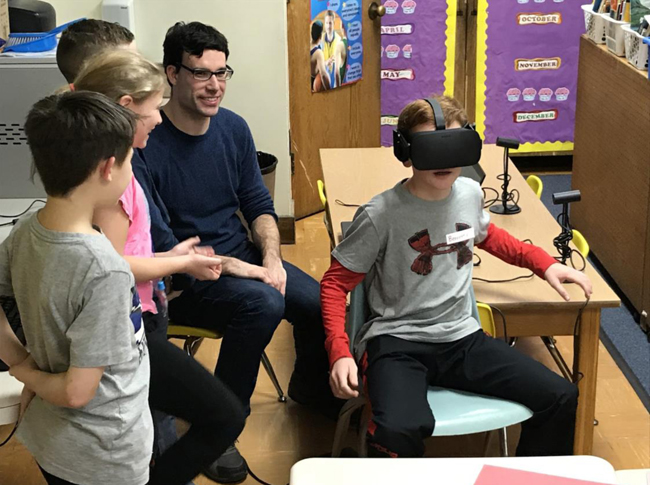
To help create a NYS K-12 curriculum standard specific to marine, coastal, and environmental science, a research team led by investigators at Hofstra University and Adelphi University will work on educational resources to train and inspire the next generation of scientists and environmental stewards. The key will be to emphasize innovative methods, including visual tools such as this virtual reality hurricane simulation that lead PI Jase Bernhardt (at left, in dark blue shirt) has brought to students of a K-12 school on Long Island. Credit: Jase Bernhardt
Developing and Evaluating an Interdisciplinary Coastal Science Curriculum ($134,704)
• Jase Bernhardt, Department of Geology, Environment and Sustainability, Hofstra University
• Mary Jean McCarthy, The School of Education, Adelphi University
There is no standard K-12 curriculum in New York State that is both specific to marine, coastal, or environmental science, and relevant to communities that live in coastal zones. Barriers exist to the development, adoption, and evaluation of such a curriculum, including the limited time and the topical expertise of educators. Identifying key knowledge gaps in student understanding is another critical component of effective curriculum development.
In response to these challenges, a research team led by Drs. Bernhardt and McCarthy will coordinate a team of experienced earth science educators at the secondary and postsecondary levels and will collaborate with local civic organizations to develop a community-focused coastal science curriculum inclusive of diverse viewpoints and includes coastal zones and communities in Long Island, New York City, and the Hudson River Estuary. Completion of this project will result in educational resources to train and inspire the next generation of scientists and environmental stewards.
“In this project, we hope to implement an innovative and inclusive coastal science curriculum at K-12 schools across New York State,” Bernhardt said. “Follow-up surveys and interviews with the students and teachers involved will help us understand the benefits of the curriculum, along with areas for improvement.”
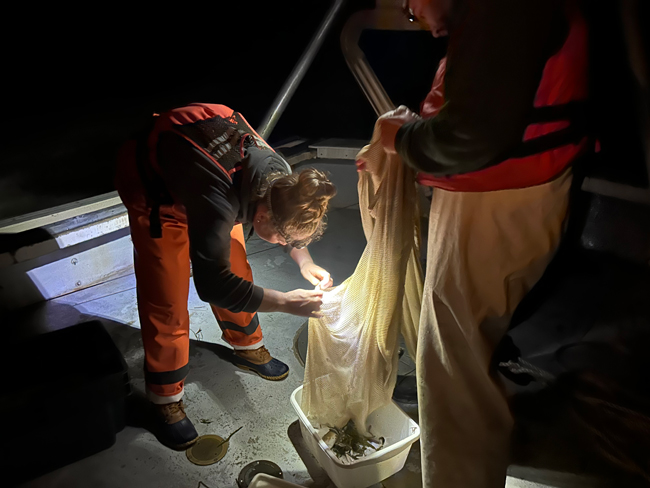
NYS Department of Environmental Conservation-supported Fall Juvenile Survey, a source of data for an SBU-led NYSG-funded research project to develop an ecosystem-dynamics model, collects data on juvenile fish in the Hudson River. (At right) Jared Parsons (Normandeau Associates, Inc.) holds the nets of a beam trawl while Katrina Rokosz (SBU) searches the net for juvenile fish. Credit: Willa Schultz
Developing an End-To-End Ecosystem Model to Inform Management of the Hudson River and New York Bight Ecosystem ($215,368)
• Yong Chen, School of Marine and Atmospheric Sciences, Stony Brook University
Dr. Chen aims to develop and test an end-to-end ecosystem dynamics model for the Hudson River Estuary and New York Bight (HRE and NYB). The process-based model will link key environmental, biological, and fisheries variables including temperature, salinity/freshwater inputs, dissolved oxygen, water quality, water runoff, and sewage releases. The model will also integrate low and high trophic levels of organisms from phytoplankton and zooplankton to fishes of commercial and recreational importance. The HRE and NYB provide critical habitat for many ecologically and economically important fish species. The ecosystem dynamics model proposed in this project will allow managers and stakeholders to evaluate potential impacts of climate change and other anthropogenic and environmental changes on the HRE and NYB ecosystem and inform its management.
“We plan to develop and test an ecosystem model that can quantify the dynamics of most key ecological elements in the Hudson River Estuary and New York Bight,” Chen said. “Such a model can be used to evaluate potential impacts of anthropogenic and environmental changes and inform the management of this important ecosystem in the state of New York.”
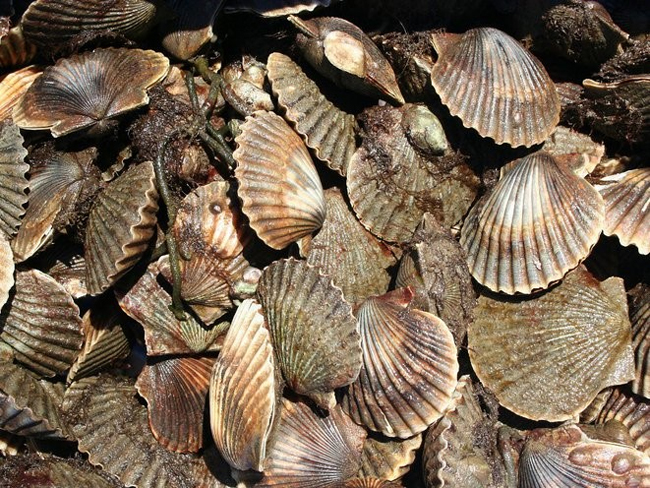
High temperatures and heat wave events have exacerbated the vulnerability of the bay scallop, seen here, to hypoxia (low dissolved oxygen) and contributed to the collapse of the fishery. Researchers at Stony Brook University are conducting studies to help ensure the future viability of this and other shellfisheries in NY. Credit: Stony Brook University
The Current and Future Impacts of Warming and Low Oxygen on The Sustainability of Shellfisheries Across New York ($239,803)
• Michael Doall and Christopher Gobler, School of Marine and Atmospheric Sciences, Stony Brook University
• Stephen Tomasetti, Department of Natural Sciences, University of Maryland Eastern Shore
Shellfish have historically been an important contributor to the cultural, commercial, and ecological identity of New York. Although at times New York has led the nation in shellfish production among certain species, warming waters and shifts in the distribution or dynamics of dissolved oxygen may alter the composition of shellfisheries across the state and leave certain shellfisheries vulnerable to declines. Researchers will be developing a detailed characterization of present and future temperature and dissolved oxygen dynamics in New York estuaries. This will be combined with previous and new experimental data to determine ideal and inhibitory locations for seven commercially-important shellfish species under future climate change scenarios. These details will enable managers, fishers, and aquaculturists to prepare for future change.
“This project will provide guidance on the shellfisheries that are most and least likely to flourish under future climate change scenarios, as well as the places in New York most suitable for different shellfish species into the future," Tomasetti said.
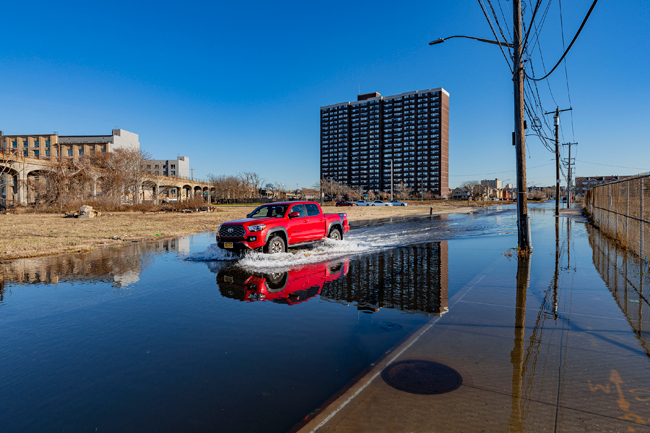
A research team from SBU will examine communicating flood risks from extreme rainfall and storm surges to vulnerable communities around Jamaica Bay. Here, a truck drives down a street near the shore in Far Rockaway, Queens impacted by a January 2022 “sunny day” high tide flood event, which, for comparison sake, is considered a chronic nuisance occurrence. Credit: Giles Ashford, NYC Community Flood Watch Project
Improving Risk Communication for Extreme Rainfall Events in Vulnerable Coastal Communities: A Case Study for Jamaica Bay ($239,797)
• Donovan Finn and Kevin Reed, School of Marine and Atmospheric Sciences, Stony Brook University
• Christine Gilbert, School of Communication and Journalism; School of Marine and Atmospheric Sciences Stony Brook University
The Jamaica Bay region is vulnerable to extreme weather events, a risk made all too clear by the devastation of Hurricane Sandy in 2012. Events such as floods and extreme rainfall are difficult to predict and are challenging to communicate. As these events are expected to increase in frequency and intensity, new communication strategies are needed. This project will harness expertise in climate science, community engagement, urban adaptation planning, and communication studies to address these risks. Storylines—forms of narrative—have great potential for communicating facts and shaping attitudes. The project will result in new knowledge and tools for communicating risk, both long-term and short, about weather events and climate change.
“With our project we hope to uncover some of the communication barriers that exist between climate scientists and public officials on the one hand, and the messages that communities hear related to climate change induced risk on the other hand,” Finn said. “We will then develop new communication strategies to inform local residents about climate risks in ways that are more useful and effective.”
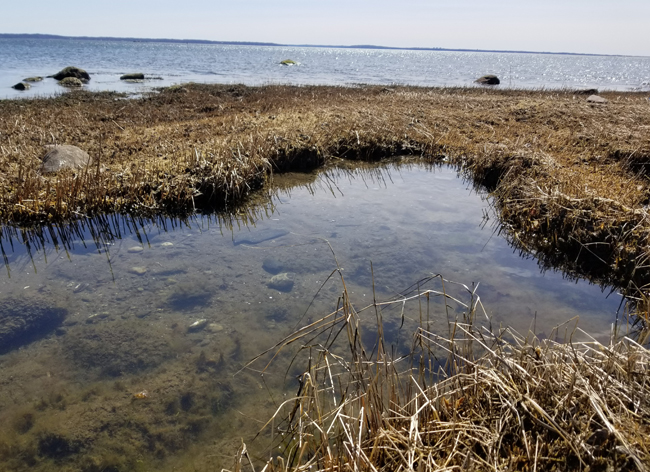
Investigators at SBU will examine hypoxic (low dissolved oxygen) conditions in locations along Long Island Sound’s western basin, where they most commonly occur. The early spring tide pools pictured here along the coast of Long Island Sound's western basin are located at the Edith Read Wildlife Sanctuary in Rye, NY. Credit: Lillit Genovesi/NYSG
AI-Based Forecast Tool for Prediction of Hypoxia Occurrence in Long Island Sound ($218,361)
• Kamazima Lwiza, School of Marine and Atmospheric Sciences, Stony Brook University
This project focuses on the causes of hypoxia in the Long Island Sound. Hypoxia or low dissolved oxygen conditions are driven by nitrogen pollution and are a critical problem for coastal waters, including being associated with die-offs of ecologically and economically important fish species. In this study, the researchers want to understand the causal factors that determine the volume and extent of hypoxic zones. They are interested in developing a machine learning model that requires far less computational power than existing three-dimensional hydrodynamic models. Regional working groups and stakeholders have shown a keen interest in developing better predictive tools for summer hypoxic conditions. The knowledge gained from these tools can be used to forecast and manage hypoxia by determining, for example, optimal allowable nutrient loads, which is the primary management tool for addressing LIS hypoxia.
“We envision developing an attention-based convolutional neural network transformer to improve seasonal prediction of hypoxia occurrence in Long Island Sound with a 3-6 month forecast range,” Lwiza said.
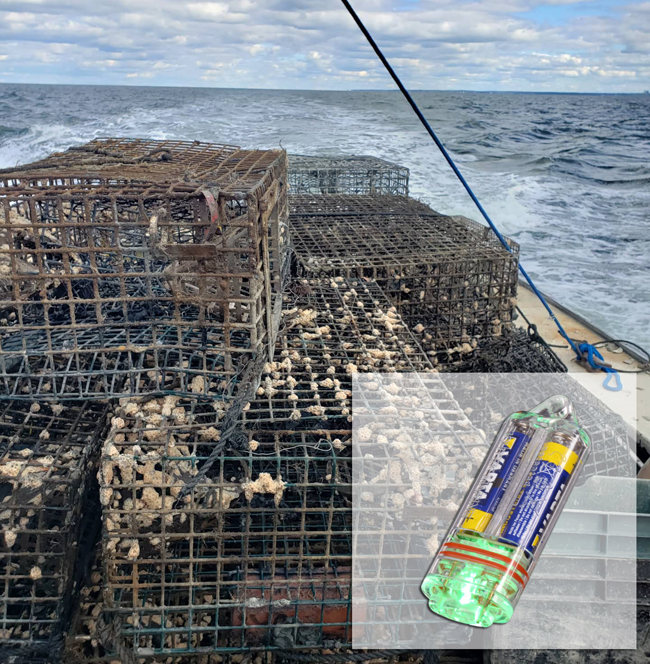
A Cornell Cooperative Extension of Suffolk County (CCE Suffolk) project will examine the effect of LEDs (Light Emitting Diodes) in pots of New York crustacean fisheries. In the past, Jonah crabs were an unintentional catch in the lobster harvester’s trap. More recently, the crabs are viewed as a target species. Commercial fish harvesters have increasingly been shifting their target species from lobster to Jonah crab due to changing species populations. Credit: CCE Suffolk; Inset: PotLights, a product for the crab and lobster fishing industry, are LED lights designed to increase catch rates while reducing or eliminating the need for natural baits. Credit: PotLights
Examining the Effect of LEDs (Light Emitting Diodes) in Pots of New York Crustacean Fisheries ($163,655)
• Alexander Mercado and Michael Bowen, Cornell Cooperative Extension of Suffolk County Marine Program
Researchers will examine the effect of LED lights in pots of New York crustacean fisheries, specifically the Jonah crab (Cancer borealis) fishery. Commercial fish harvesters have increasingly been shifting their target species from lobster to Jonah crab due to changing species populations. PotLights, a product for the crab and lobster fishing industry, are LED lights designed to increase catch rates while reducing or eliminating the need for natural baits. This product has been shown to be effective in other crustacean fisheries, but has not yet been evaluated for Jonah crabs. This study will compare different combinations of light and bait (or absence of light and bait) to assess impacts on overall catch rates. If successful, the tool could reduce bait expenses for fishers and reduce pressure on bait species such as herring, menhaden, and skate. Cornell Cooperative Extension of Suffolk County will include an outreach and extension component to share results with interested stakeholders, particularly pot fishermen in the Greater Atlantic Region.
“We hope that this project will help us to identify additional strategies for fishermen to utilize in their day-to-day operations,” Mercado said. “If successful, the use of cost-effective LED lights to supplement natural bait would be both ecologically and economically beneficial.”
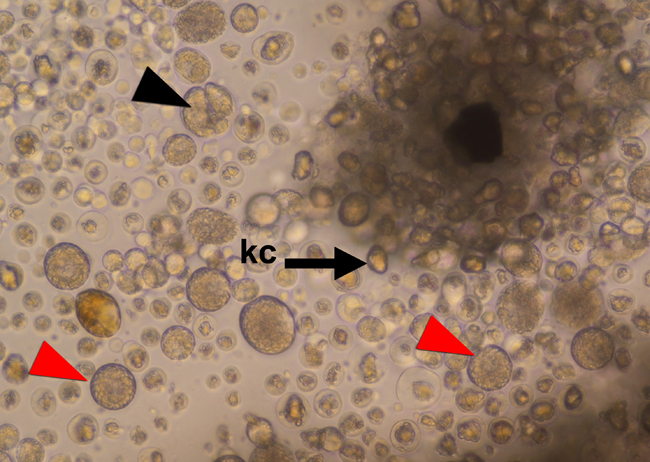
Stony Brook University investigators are helping to identify risk factors associated with shellfish disease outbreaks such as the bay scallop Marosporida (BSM), an emergent parasite of adult bay scallop seen here in a mixture of crushed scallop kidneys. Red and black arrowheads represent single and dividing BSM, respectively. The notation “kc” refers to kidney concretions — also known as stones. Credit: Pales Espinosa
Characterization and Dynamics of Bay Scallop Marosporida (BSM), an Emergent Parasite of Argopecten irradians irradians ($239,989)
• Emmanuelle Pales Espinosa and Bassem Allam, School of Marine and Atmospheric Sciences, Stony Brook University
• Stephen Tettelbach and Harrison Tobi, Cornell Cooperative Extension of Suffolk County
• Emma Green-Beach, Martha’s Vineyard Shellfish Group
Adult bay scallop (Argopecten irradians irradians) populations in the Peconic Estuary (on the east end of Long Island) have undergone severe declines since 2019. These mortality events have been associated with disease outbreaks caused by an apicomplexan parasite belonging to a new class called Marosporida. These parasites tend to attack kidney tissues of scallops but can also affect the muscles, gonads, and gills. Similar parasites have been documented to have dramatically affected the scallop fishery in Iceland. Scientists are working to understand how scallops become infected and determine areas of high and low risk. While the study will be focused on the Peconic Estuary and on other sites in New York, the findings could have benefits for the scallop fishery more broadly.
“This project is expected to generate information needed to understand factors affecting disease dynamics in the bay scallop in New York fisheries, and also evaluate the risk of disease outbreaks in other regional bay scallop fisheries,” Pales Espinosa said.
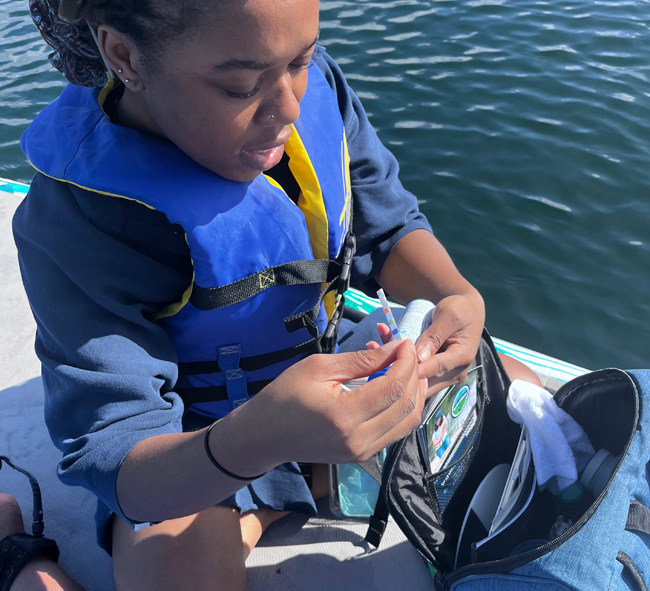
Cornell University researchers working in NY Great Lakes coastal waters will develop eDNA (DNA found in the environment) based tools to simultaneously survey multiple risks in waterbodies. Here, Water Rangers' Praise Osifo samples the waters of British Columbia. Credit: Nik Maclean
Integrated Biomonitoring of NY Coastal Waters: Aquatic Invasive Species, Fecal Contamination Source Tracking Markers, and Toxic Cyanobacteria ($240,000)
• Ruth Richardson, Civil and Environmental Engineering, Cornell University
• Jose Andres, Ecology and Evolutionary Biology, Cornell University
• Gabrielle Parent-Doliner, Water Rangers
New York waters face multiple biological threats, yet ongoing biomonitoring tends to be highly specialized to one invasive species, type of pathogen, or contaminant. In this project, the researchers propose to use eDNA (environmental DNA) to simultaneously survey for multiple risks in waterbodies. They hope to use an integrated method to test for invasive species, contaminants, and the types of algae and cyanobacteria that cause harmful algal blooms (HABs). If successful, they could detect tens to hundreds of targeted factors with high reliability at low cost.
“Our goal is to provide a single, flexible, cost-effective molecular tool for the co-detection of waterborne fecal pathogens, harmful algal blooms (HABs), and aquatic invasive species (AIS), Richardson said. “This tool could aid in future management efforts ranging from early warnings to monitoring to mitigation to remediation. Additionally, we will foster networks of stakeholders from diverse New York–based institutions, federal, state, and local agencies, nonprofits, and tribal nations. We will also reach out to experts in diverse management focal areas, including HABs, AIS, and fecal pollution.”
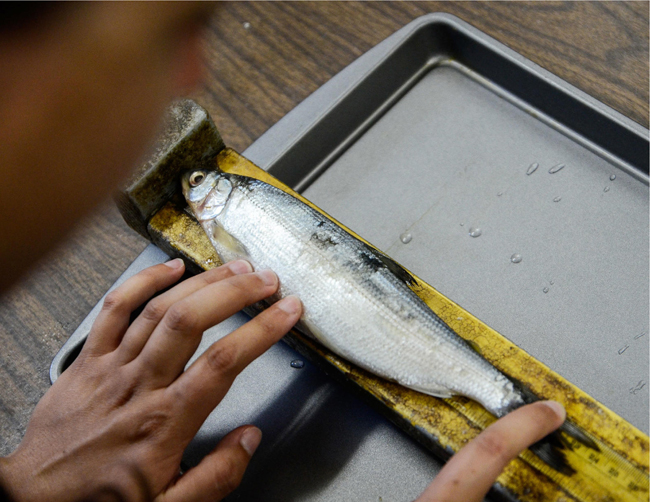
Cisco, the focus of a Cornell University-led project, was once a commercially and ecologically important fish in Lake Ontario. The study described the genetic diversity of cisco populations to inform restoration efforts. Credit: Heather Ainsworth
Navigating Lake Ontario Coregonine Restoration: Analysis of Contemporary and Future Food Web Structures ($239,947)
• Lars Rudstam, James Watkins, and Suresh Sethi, Department of Natural Resources and the Environment, Cornell University
• Tom Stewart, Retired – Ontario Ministry of Natural Resources and Forestry
Restoring native fish is considered beneficial to food web production. Thus, the restoration and stocking of a type of fish called coregonines across the Great Lakes could be important for stabilizing the prey fish population and by extension the salmonid sport-fisheries in these lakes. Yet the assumptions behind these programs and their results have not been fully assessed. The researchers aim to use modeling tools to better understand Lake Ontario food webs. They will evaluate contemporary and future food webs that include restored populations of coregonines such as bloater and cisco as a parameter in the models. They hope to assist managers with lake-scale food web scenario outcomes.
“We expect this research to give us important insights into the functioning of the Lake Ontario food web and how the restoration of native fishes will affect the valuable sport fishery in the lake,” Rudstam said. “This grant will allow us to delve deeper into this issue with new modeling methods.”
More Info: New York Sea Grant
New York Sea Grant (NYSG), a cooperative program of Cornell University
and the State University of New York (SUNY), is one of 34 university-based
programs under the National Oceanic and Atmospheric Administration’s
National Sea Grant College Program.
Since 1971, NYSG has represented a statewide network of integrated
research, education and extension services promoting coastal community
economic vitality, environmental sustainability and citizen awareness
and understanding about the State’s marine and Great Lakes resources.
Through NYSG’s efforts, the combined talents of university scientists
and extension specialists help develop and transfer science-based
information to many coastal user groups—businesses and industries,
federal, state and local government decision-makers and agency managers,
educators, the media and the interested public.
The program maintains Great Lakes offices at Cornell University, SUNY
Buffalo, Rochester Institute of Technology, SUNY Oswego, the Wayne County Cooperative Extension office
in Newark, and in Watertown. In the State's marine waters, NYSG has offices at Stony Brook
University and with Cornell Cooperative Extension of Nassau County on Long Island, in Queens, at Brooklyn College, with Cornell Cooperative
Extension in NYC, in Bronx, with Cornell Cooperative Extension of Ulster County in Kingston, and with Cornell Cooperative Extension of Westchester County in Elmsford.
For updates on Sea Grant activities: www.nyseagrant.org has Facebook, Twitter/X, Instagram, and YouTube links. NYSG offers a free e-list sign up via www.nyseagrant.org/nycoastlines for its flagship publication, NY Coastlines/Currents, which is published quarterly.